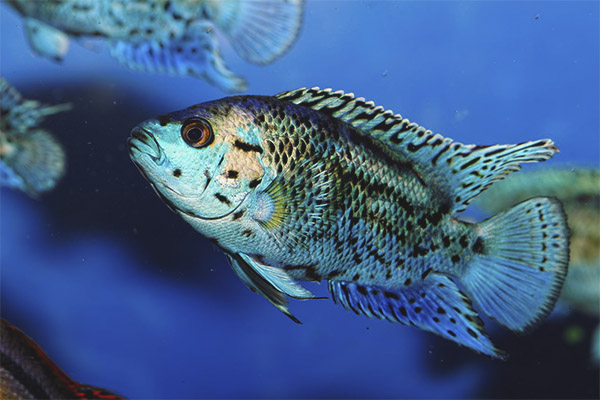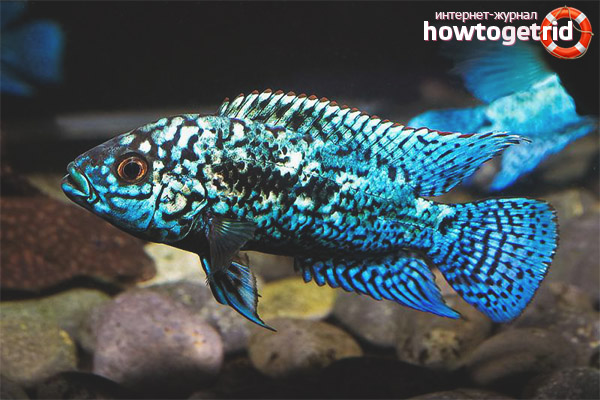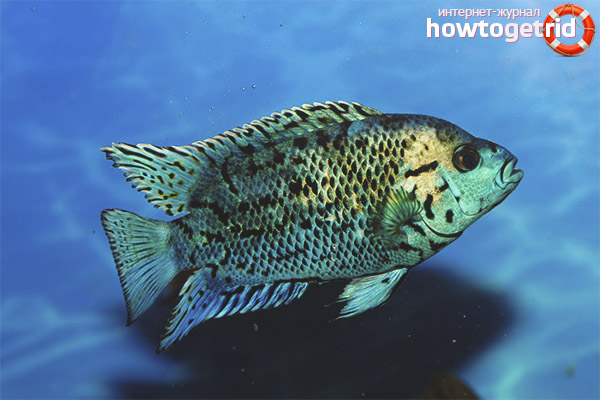The content of the article
In the water sources near Honduras and Mexico you can find a wonderful fish, which belongs to the family of cichlids. The species is called Blue Dempsey, the color of the water representatives is specific. The fish look like a striped chick-eye, but their color is different. Also temperament is different, blue dumps are not too aggressive.
Origin
Before Blue Dempsey was discovered, ichthyologists performed a lot of research and crossing. As a result, the fish were obtained artificially, G. Luzardo from Argentina is considered its founder. Aquarist, researcher and simply endowed with a passion for fish man was able to bring out such beauty.
It all started with the fact that the man gave a few fish from the family tsihlazom. He did a tremendous job, as a result of which he received an individual with a blue glow and pearl shimmer. Since the diamond tsikhlazom participated in the crossing, the signs of aurorae came to the Blue Dempsey from her predecessor.
After his observations, the researcher concluded that it is necessary to include this species of fish in a separate subgroup. This is how a neon beauty appeared, which today is admired by millions of people.
Description
Male sex is brighter and more memorable than female. In males you can see a black speck on the tail and body. As befits a similar family of fish, males have long and pointed fins (dorsal and posterior).
If you observe these representatives of the aquatic environment, several important characteristics can be noted. The behavior of males and females is different, individuals can reach a length of 20 cm and even more. By their characteristics, fish do not require scrupulous care and special conditions to the content.
The fish have expressive eyes, a big head. The oral cavity is wide, edged dark.The females seem to be painful, in fact, with the health of their all is well with the provision of appropriate conditions. Males are happier, so to speak.
The fish has a main feature: they find a mate from an early age, then hold on to their mate and are always together. Even if the male or female dies, the second individual will not find a replacement, being alone for the rest of his life.
Content
- In order for all the inhabitants of the aquatic environment to be in their dwelling with comfort, it is necessary to choose conditions as close as possible to the natural habitat. The temperature regime should not go beyond that set, that is, vary within 25-29 degrees.
- As for stiffness, its optimal performance is 8-12 units with an acid balance of 6.5-7 units. Fish can not be kept at temperatures below 23 degrees, otherwise they can get sick.
- Blue Dempsey love to fight for their territory, so it is important that all the inhabitants of the aquarium have enough space. On an adult relies 150 liters. water. Sometimes the volume increases to 200 l., If you plan to grow an inmate larger.
- Fish, by nature, are angry for no reason, when signs of aggression appear, it is necessary to set the water temperature to 26 degrees and wait.If the figures fall to 8 degrees, for the inhabitants of the aquarium it will be fatal.
Feeding
- Those considered tsihlazom very good appetite. These fish are almost not picky in the diet, so they eat almost everything. Their diet includes both live food and various plants. Adult fishes can eat everything indiscriminately. Therefore, you can feed them both live and dry or frozen substrate.
- The basis of the diet tsihlazom include a variety of larvae and large bloodworm. They also eat well all sorts of insects, worms, Artemia, tubule, small crustaceans, shrimps, small fish, fry. Blue tsikhlazomy different gluttony. Therefore, it is recommended to feed them about 4 times a day.
- Particular preference is given to such individuals mixtures of shrimp, trout fillet, moths and mussels. Be especially careful of feed from mammal and meat by-products. This feed is high-calorie. Because of this, it is poorly absorbed. In fish, often due to this composition, obesity develops, accompanied by pathological abnormalities.
- If you do not want your tsikhlazomy not to hurt anything and feel perfectly, it is recommended to give them feed mixtures of well-known manufacturers. Among them should be highlighted "NEO ZIKHLID MIX" and "NEO TROPIK DIET". Such compositions have excellent balance. The feed contains all the necessary vitamins for fish. The product also contains herbal supplements.
Breeding
- If you are not going to receive exclusively popularity of the presented species from a pair of tsikhlaz, then you will not have any particular problems. You can easily understand when individuals are ready to mate. This can be determined by the state of the copulative organ in the male. Milk will be separated from the organ.
- Also, the female will begin to spawn cone-shaped eggs. In the marriage period, you can see all this without any problems. At this time, you will be required to hold some events. A couple must be transplanted into a separate aquarium. The temperature of the medium should be increased to 30 degrees. In this case, the water should be replaced 1 time in 3-4 days.
- If everything is done correctly, then spawning will begin in about 6-8 days. In total, from all clutches, the female sweeps about 2000 eggs.Sometimes masonry may be in unexpected places. Therefore it is worth checking plants, stones and all decorative items. Presented tsikhlazomy prefer to lay eggs in cozy shelters. Also, the fish themselves dig holes in the ground.
- As soon as the male fertilizes the spawn, the parents start watching the babies very closely and jealously. Therefore, cychlasmas can attack anyone who comes close. Bite tsikhlazomy quite noticeable. During this period, individuals do not control all aggression and can even attack their brood. As soon as the offspring appear after 3 weeks, parents are best transplanted into a common aquarium.
- In the first days of birth, the fry will have a fairly light color. Small fish up to 1 month will be subject to various diseases. To significantly reduce the risk of an epidemic, the temperature of the environment is recommended to increase to 32 degrees. In the first few days the young will be able to gain strength. After just one month, they will not be susceptible to illness.
Blue tsikhlazomy quite interesting fish. They have a beautiful color. Do not forget that individuals love to eat.Provide your fish with the right diet and good housing conditions. Be attentive to the young. Do not forget that parents can show aggression even to their offspring.
Video: Blue Dympsey Cichlasoma (Cichlasoma sp Blue Dempsey)













To send